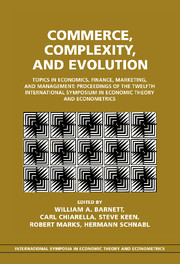 Commerce, Complexity, and Evolution
Commerce, Complexity, and Evolution Book contents
- Frontmatter
- Contents
- Series editor's preface
- Volume editors' preface
- Editors
- List of contributors
- I Philosophical and methodological implications of complexity and evolution in economic systems
- II Finance and the macroeconomy
- III Market and sectoral dynamics
- 10 Evolutionary patterns of multisectoral growth dynamics
- 11 The detection of evolutionary change in nonlinear economic processes: a new statistical methodology
- 12 Ergodic chaos in a piecewise linear cobweb model
- 13 The cobweb model and a modified genetic algorithm
- 14 The convergence of genetic learning algorithms, with particular reference to recent cobweb models
- IV Marketing and interdependent behavior
12 - Ergodic chaos in a piecewise linear cobweb model
Published online by Cambridge University Press: 05 December 2011
- Frontmatter
- Contents
- Series editor's preface
- Volume editors' preface
- Editors
- List of contributors
- I Philosophical and methodological implications of complexity and evolution in economic systems
- II Finance and the macroeconomy
- III Market and sectoral dynamics
- 10 Evolutionary patterns of multisectoral growth dynamics
- 11 The detection of evolutionary change in nonlinear economic processes: a new statistical methodology
- 12 Ergodic chaos in a piecewise linear cobweb model
- 13 The cobweb model and a modified genetic algorithm
- 14 The convergence of genetic learning algorithms, with particular reference to recent cobweb models
- IV Marketing and interdependent behavior
Summary
The emergence of complex dynamics in a cobweb model augmented with upper and lower bounds for output variations is demonstrated. The purpose is to consider the implications of the output constraints on the dynamic behavior of an agricultural economy.
The traditional cobweb model, which has monotonic specifications of demand and supply and naive or adaptive expectations formation, can produce only three types of dynamics: convergence to an equilibrium, convergence to period-2 cycles, or divergence. None of these types, however, is satisfactory to explain the irregular and asymmetric fluctuations of agricultural goods markets.
To overcome those limitations, the literature on nonlinear cobweb dynamics has been expanding with the help of new developments in nonlinear dynamics. Several stability results have been established that show the existence of chaotic fluctuations as well as the convergence to stable periodic cycles. The literature fall into two groups. In the first, we have endogenous nonlinear cobweb models in which the supply-and/or-demand curves are nonlinear (see Jensen and Urban 1984, Chiarella 1988, Finkenstadt and Kuhbier 1992, and Hommes 1994). By nonlinear behavioral assumptions, transition maps in the first group are more or less similar to the logistic map that is able to give rise to complex dynamics involving chaos. In the second, we find a linear cobweb model with a upper bound for variations of output. Owing to the upper-quantity constraint, the transition map in the second ground is also nonlinear (or, more precisely, piecewise linear) in spite of the linear behavioral specifications. In particular, it is similar to the tent map that is able to generate complex dynamics.
- Type
- Chapter
- Information
- Commerce, Complexity, and EvolutionTopics in Economics, Finance, Marketing, and Management: Proceedings of the Twelfth International Symposium in Economic Theory and Econometrics, pp. 253 - 266Publisher: Cambridge University PressPrint publication year: 2000


